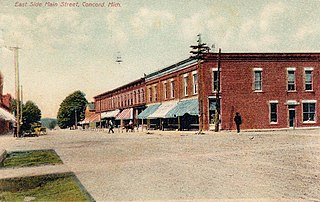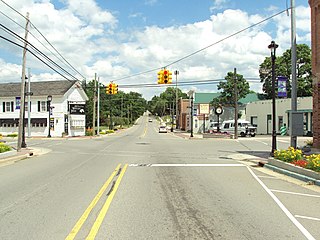
Oakland County is a county in the U.S. state of Michigan. It is part of the metropolitan Detroit area, located northwest of the city. As of the 2020 Census, its population was 1,274,395, making it the second-most populous county in Michigan, behind neighboring Wayne County. It is the largest county in the United States without a city of 100,000 residents. The county seat is Pontiac. The county was founded in 1819 and organized in 1820.

Independence Township is a charter township of Oakland County in the U.S. state of Michigan. The population was 34,681 at the 2010 census.

Clarkston is a city in Oakland County, Michigan, United States. The city is surrounded by Independence Township, but the two are administered autonomously. At the 2010 census, the city had a population of 882.

Northville is a city in Oakland and Wayne counties in the U.S. state of Michigan. The population was 5,970 at the 2010 census.

Victorian architecture is a series of architectural revival styles in the mid-to-late 19th century. Victorian refers to the reign of Queen Victoria (1837–1901), called the Victorian era, during which period the styles known as Victorian were used in construction. However, many elements of what is typically termed "Victorian" architecture did not become popular until later in Victoria's reign, roughly from 1850 and later. The styles often included interpretations and eclectic revivals of historic styles (see Historicism). The name represents the British and French custom of naming architectural styles for a reigning monarch. Within this naming and classification scheme, it followed Georgian architecture and later Regency architecture, and was succeeded by Edwardian architecture.

Basilica of Sainte Anne de Détroit (Sainte-Anne-de-Détroit) was founded July 26, 1701 by French colonists in New France, and is the second-oldest continuously operating Roman Catholic parish in the United States. The current Gothic Revival cathedral-styled church, built in 1886, is located at 1000 St. Anne Street in Detroit, Michigan, in the Richard-Hubbard neighborhood, near the Ambassador Bridge, and the Michigan Central Station. At one time it was the seat of a diocese that included French territory in Ontario, Canada south of the Detroit River.

The Jefferson–Chalmers Historic Business District is a historic district located on East Jefferson Avenue between Eastlawn Street and Alter Road in Detroit, Michigan. The district is the only continuously intact commercial district remaining along East Jefferson Avenue, and was listed on the National Register of Historic Places in 2004.

Farmington Historic District is the town center of Farmington, Michigan. It was listed on the National Register of Historic Places in 1976. The area roughly corresponds to the section of Grand River Avenue and Shiawassee Avenue from Warner Street to junction of Grand River and Shiawassee.

The Concord Village Historic District in Concord, Michigan dates back to 1836, and consists of historic structures located along Hanover Street from Spring to Michigan Streets and North Main Street from Railroad to Monroe Streets. It was listed on the National Register of Historic Places in 1996.

The Saint Paul Catholic Church Complex is located at 157 Lake Shore Road in the Detroit suburb of Grosse Pointe Farms, Michigan. The group includes a French Gothic-style church, a Neo-Tudor rectory, a Colonial Revival parish hall, a Neo-Tudor school building, and an Elizabethan Revival convent. The complex was designated a Michigan State Historic Site in 1992 and listed on the National Register of Historic Places in 1994.

The Sheldon Inn was a two-story apartment building located at 44134 Michigan Avenue, in Sheldon Corners in Canton Township, Michigan. It was built in 1825, and previously used as a single-family home and a travelers' inn. It was listed on the National Register of Historic Places in 2000. It was demolished in 2021.

The Thomas and Maria Blackman Bartlett House was built as a private house at the corner of Canton Center and Warren Roads. It was donated to Canton Township and relocated to its current site at 500 N. Ridge Road in Cherry Hill, Michigan. It was listed on the National Register of Historic Places in 2000.

The Canton Township MPS is a multiple property submission, listed on the National Register of Historic Places in 2003. A multiple property submission is a group of related structures that share a common theme. The Canton Township MPS consists of eleven houses built between 1825 and 1904 and located in Canton Township, Michigan.

The Dundee Township Historic District is a set of sixty-five buildings in Dundee Township, Kane County Illinois. Buildings in the district are found in East Dundee, West Dundee, and Carpentersville. The district represents the development of the upper Fox River Valley from 1870 to the 1920s. Dundee Township became an important industrial area, especially following the construction of the Dundee Brick Company in West Dundee and the Illinois Iron and Bolt Company in Carpentersville. Also included in the district are a variety of Queen Anne, Italianate, and Greek Revival style houses and Gothic Revival churches. The majority of the historic district lies within the boundaries of West Dundee. It was added to the National Register of Historic Places in 1975.

The East River Road Historic District is a historic district located along East River Road near the Grosse Ile Parkway in Grosse Ile, Michigan. The district includes eleven structures, including seven houses, two outbuildings, St. James Episcopal Church, and the Michigan Central Railroad depot. The district stretches from St. James Episcopal Church on the south to Littlecote on the north. The district was designated a Michigan State Historic Site in 1972 and listed on the National Register of Historic Places in 1973. The historically significant 1870s customs house was moved into the district in 1979.

The Metamora Crossroads Historic District is a historic district centered at the intersection of Oak and High Street in the small village of Metamora in Metamora Township in Lapeer County, Michigan. It was designated as a Michigan State Historic Site and also added to the National Register of Historic Places on July 19, 1984.

Waterford Village is an historic community in Waterford Township, Michigan. First settled in 1819, the village is located in the northernmost part of the township along Dixie Highway, on the southeast shore of Van Norman Lake.

The Danby Village Historic District encompasses much of the town center of Danby, Vermont. It is centered on a stretch of Main Street, roughly between Depot Street and Brook Road. The village has a cohesive collection of mid-19th century architecture, mostly residential, with a modest number of later additions. The district was listed on the National Register of Historic Places in 1983.
Waterford Hill is located in Independence Township, in Oakland County, Michigan, 0.4 miles north of Waterford Village. The hill is classified as a summit. It extends from east of Dixie Highway including Ottawa Park Cemetery to the east, to Maple Lane in Moon Valley to the north, to Parview Drive and Greens Lake to the west, to Van Norman Lake to the south.

The Asbury Historic District is a 288 acres (117 ha) historic district encompassing the community of Asbury in Franklin Township of Warren County, New Jersey. It is bounded by County Route 632, County Route 643, Maple Avenue, Kitchen Road, and School Street and extends along the Musconetcong River into Bethlehem Township of Hunterdon County. It was listed on the National Register of Historic Places on March 19, 1993 for its significance in architecture, industry, religion, community development, politics/government, and commerce. The district includes 141 contributing buildings, a contributing structure, two contributing sites, and four contributing objects.



















